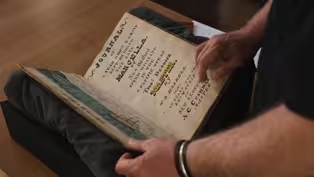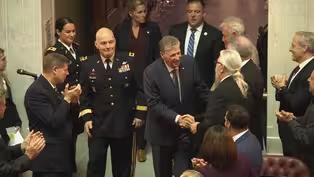
Green Seeker: Eroding History
Clip: Season 6 Episode 3 | 10m 21sVideo has Closed Captions
What happens when climate change causes sea level rise threatening Rhode Island’s history?
Climate change is driving sea level rise, flooding, and shoreline erosion. Extreme weather like hurricanes and noreasters is increasing in frequency and severity, especially along New England’s famed coastal areas. In its path are some of Rhode Island’s prized pieces of real estate: historic properties.
Problems playing video? | Closed Captioning Feedback
Problems playing video? | Closed Captioning Feedback
Rhode Island PBS Weekly is a local public television program presented by Ocean State Media

Green Seeker: Eroding History
Clip: Season 6 Episode 3 | 10m 21sVideo has Closed Captions
Climate change is driving sea level rise, flooding, and shoreline erosion. Extreme weather like hurricanes and noreasters is increasing in frequency and severity, especially along New England’s famed coastal areas. In its path are some of Rhode Island’s prized pieces of real estate: historic properties.
Problems playing video? | Closed Captioning Feedback
How to Watch Rhode Island PBS Weekly
Rhode Island PBS Weekly is available to stream on pbs.org and the free PBS App, available on iPhone, Apple TV, Android TV, Android smartphones, Amazon Fire TV, Amazon Fire Tablet, Roku, Samsung Smart TV, and Vizio.
Providing Support for PBS.org
Learn Moreabout PBS online sponsorship(wind whooshing) Many of the country's historic landmarks are in peril.
According to the National Oceanographic and Atmospheric Administration, sea level rise is causing flooding and coastal erosion.
At the core is climate change, extreme weather such as hurricanes and nor'easters increasing in frequency and severity.
- We're on this point on Aquidneck Island, it was always called Rough Point, and that's the reason why the house's name is Rough Point, but it is in an extremely vulnerable position because of storms.
- [Pamela] Storms resulting in tough times at Rough Point.
Frankie Vagnone is president of the Newport Restoration Foundation, stewards of this 1890s estate.
It's a Gilded Age summer cottage, originally a home of Vanderbilts, and later, famed tobacco heiress Doris Duke.
It's filled with riches, such as Van Dyck portraits and a Tiffany silver swan centerpiece.
But the Bellevue Avenue mansion and the cultural heritage it holds are all at risk.
- Now what we have are climate change issues, which are increasing the storm intensity, the winds.
Normal wear and tear and weathering of this house has been kind of exponentially multiplied.
So we're getting winds at such level that the seawater's being pushed through the stonewall, through the mortar, through the interior of the wall, through the plaster.
- [Pamela] It's evident in the elegant music room, where Doris Duke's debutante ball was once held.
Alyssa Lozupone is director of preservation.
- What you're seeing on the walls is hand-painted Chinese wallpaper.
And this was one of the primary areas where we started to see water infiltration.
We started seeing damage on the wallpaper itself.
So in this area, we actually removed a panel of the wallpaper.
- [Pamela] That wallpaper is currently being conserved.
- While it was offsite, we opened up the wall and thought this is a great opportunity to start exploring what's happening behind the wallpaper.
- [Pamela] And what's happening?
- Cracked granite and brownstone, things like that are all things that let water into the building, and then it just finds its way into the finishes and all these beautiful features that you see.
(wind whooshing) - Repairing the masonry and replacing the roof is phase one of Rough Point's ongoing restoration.
Phase two will focus on the solarium, where there is a clear, fragile line between outdoors and indoors.
- This was meant to be a space where you could enjoy the view, and now we're seeing some of the damage that the proximity to the water is doing to the building.
- [Pamela] Plaster is falling, so furniture is covered.
The bronze doors and windows need repair.
- How do we restore these, and how do we continue to protect them moving forward from increased wind and increased saltwater?
- [Pamela] To answer that, the nonprofit is doing something unusual.
It's pulling back the curtain, becoming transparent about climate change calamities.
Signage throughout Rough point is prominent.
They're being very forthright about this.
- Yeah, absolutely.
- And why is that so important?
- Our visitors want to know the truth, they wanna know the reality of preservation.
So instead of, for instance, covering up falling plaster with a plastic sheet, I've suggested we take the plastic sheet down, we interpret it, we show our visitors that these are the real effects that are happening on our building.
And, of course, it's not just our building.
So it's really pushing, pushing the margins of where preservationists and museum thinkers are goring, and climate change is happening to us and these things need to be discussed.
- [Pamela] Some of that discussion is happening through the Restoration Foundation's global initiative called Keeping History Above Water.
There are international conferences with experts, aimed at balancing preservation goals with the reality of rising tides.
- Traditionally, you always wanna replace something that's rotted with the same material.
Well, today, we're dealing with issues where some of those materials may be extinct, they may be in rainforests, they may not actually be able to withstand the new climate changes, so you need to start thinking about new technologies.
You can't run away from it, because the truth is that a lot of historic properties are in extremely vulnerable places.
- [Pamela] For example, Hunter House, here in the Point neighborhood of Newport, sits just a dozen feet away from Narragansett Bay, and it is a significant structure.
- It started the preservation movement in Newport, the city as well as the county, and that begins in the 1940s.
- [Pamela] Leslie Jones is curator and director of museum affairs for the Preservation Society of Newport County.
That organization saved the house once from demolition and now is trying to save it from wreckage by climate change.
Built in 1748, it is a national historic landmark, boasting some of the finest examples of Georgian architecture, with hand-hewn paneling and angelic details.
And that's not all.
It sheltered some famous allies during the Revolutionary War.
- It was home to Admiral de Ternay, who led the French Navy.
So he could see out the windows and his fleet in the harbor.
And with that, it played a significant role in our fight for independence.
The "Gazette Francoise," which was the first French language newspaper printed in the colonies, was printed in this house.
- Nearly 250 years later, that history could be vanquished.
While seaside structures are traditionally prone to water damage, climate change is hastening the deterioration.
What's been happening here at Hunter House?
- A lot, actually, and it's affected our whole approach to how we care for the building.
So, this is called efflorescence, and it's a salt deposit.
- So all of this white is salt from the ocean?
- All this white is salt.
Well, it's salt coming through the salty air, through the saltwater that actually rises up through the water table when flooding does happen in the basement.
- [Pamela] The subterranean cellar has been specifically designed so water can flow through, with special pumping pipes on chipped stone and dehumidifiers.
Jones says they've always had a hurricane plan.
It is now morphed into a resiliency plan.
- Because it can happen at any time of the year, whether it's flooding or high winds or any kind of moisture infiltration too.
I lead the efforts for the evacuation of Hunter House when necessary, and that's a collaborative effort that is rehearsed, it is annually reviewed, and it's essentially the process of moving things out of this house into a secure location.
- However, Jones says many of the moves are just temporary mitigation.
She says it's just a matter of time until more drastic measures may be taken, such as changing the character and context of the home's location.
Is there any thought of ever putting the house on stilts, moving the house?
- Sure, yeah.
We are looking at the examples that our neighbors are doing.
There are many people in this neighborhood who are elevating their houses.
It's certainly something that our consultants, engineers, and architects have advised could be a potential action for us to take on.
- Does that hurt your heart (Leslie chuckles) as someone who's a preservationist to think it's not going to be the way it was originally?
- I think it gives us purpose, not sad or scared, but more so let's be proactive rather than reactive.
Because the whole reason why this house exists is because it has existed through a linear timeline.
It has been lived in by generations of people that have electrified it, installed internal bathrooms and plumbing.
So the house has changed and morphed, but now it's time for us to save it.
- [Pamela] Back at Rough Point, Frankie Vagnone says they are working on another innovation for both tourists and townspeople.
- What we've decided to do is to turn this wing into action centers.
- [Pamela] The action centers will occupy former guest bedrooms on the second floor now under renovation.
The idea is to promote preservation through education.
- This room will hold a large model of Aquidneck Island, with projections from the ceiling which will be talking about climate change, sea level rise.
- [Pamela] He hopes it will transform the museum into a center for schoolchildren, the community, and visitors to learn more about the threatened erosion of history.
- You have to ask yourself what the value and relevance of a historic site is to us today.
They're vessels through which you can teach contemporary issues.
Climate change is something that we all have to pay attention to, even in a rarefied house just like this.
We have no choice on the matter, just look out the window.
(wind whooshing)
Green Seeker: Whaling and Weather
Video has Closed Captions
Clip: S6 Ep3 | 8m 19s | Old whaling ship logbooks in a local library may offer up new insight into climate change. (8m 19s)
Video has Closed Captions
Clip: S6 Ep3 | 5m 12s | Governor Dan McKee addresses Rhode Islanders in his annual State of the State speech. (5m 12s)
Providing Support for PBS.org
Learn Moreabout PBS online sponsorship
- News and Public Affairs

Top journalists deliver compelling original analysis of the hour's headlines.

- News and Public Affairs

FRONTLINE is investigative journalism that questions, explains and changes our world.












Support for PBS provided by:
Rhode Island PBS Weekly is a local public television program presented by Ocean State Media

